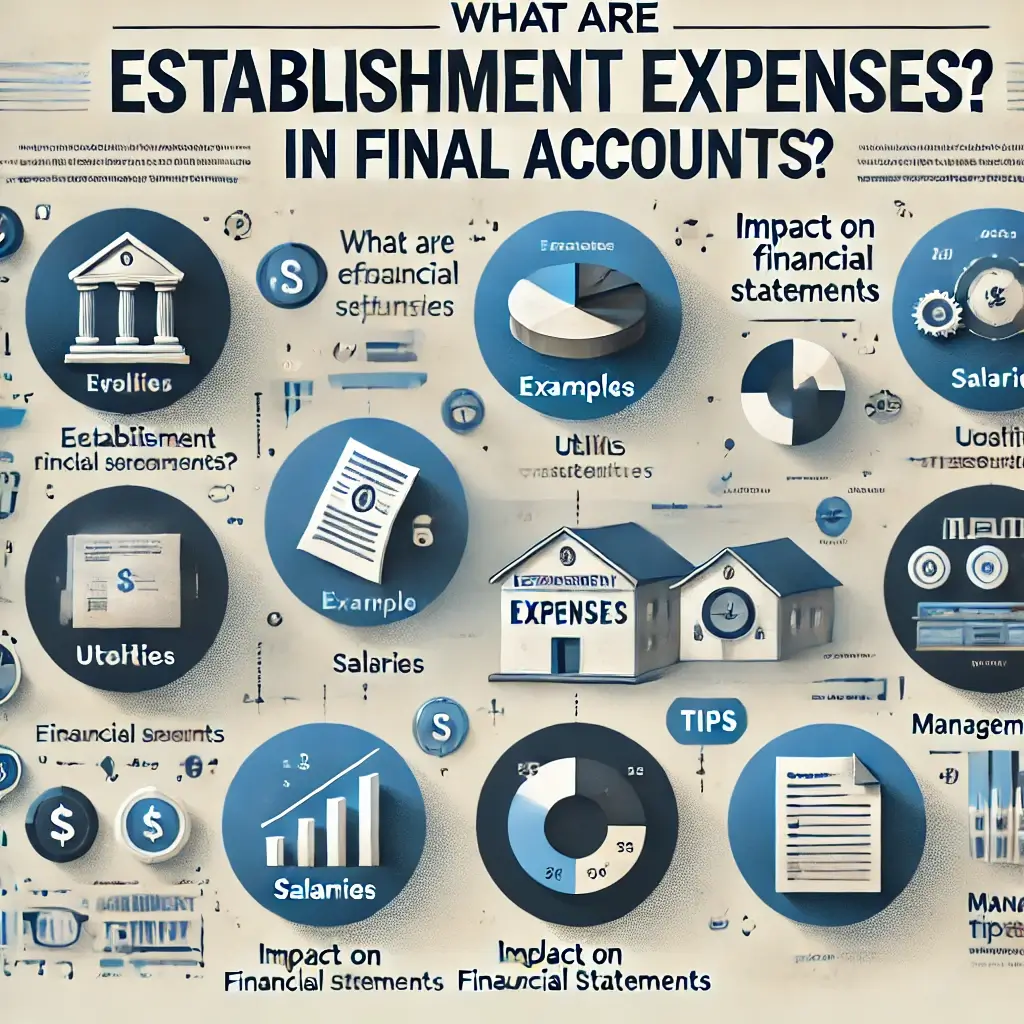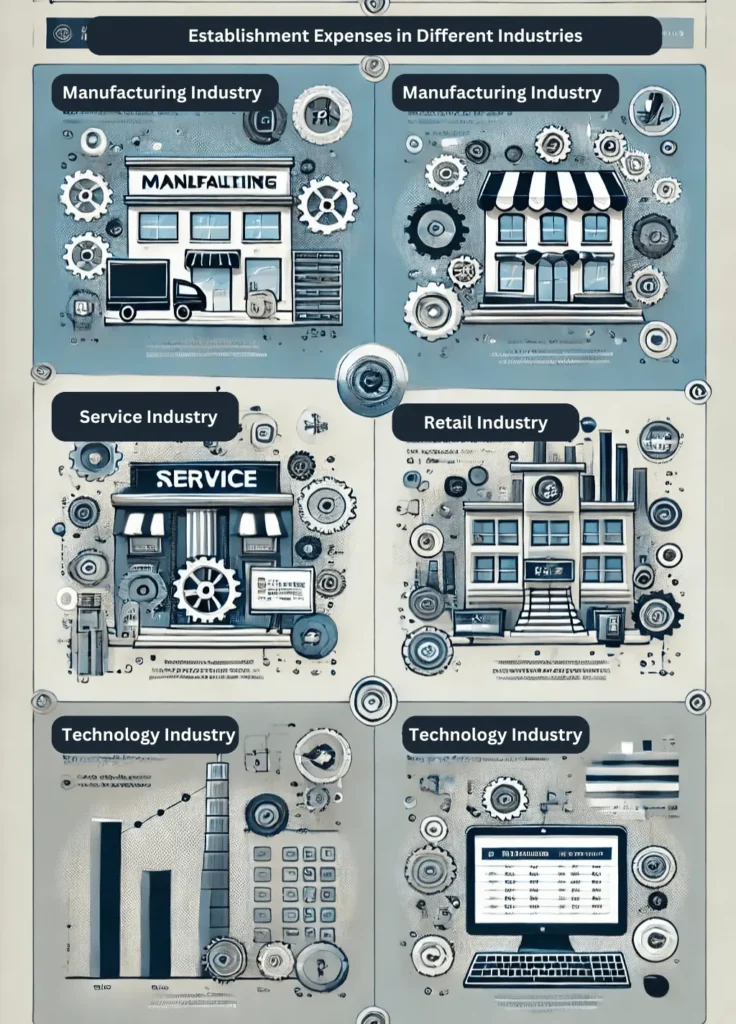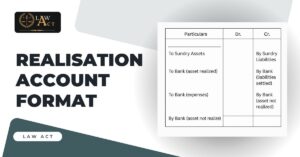Establishment expenses play a crucial role in the financial health and reporting of a business. These expenses, often termed operating expenses, cover a wide range of costs associated with the daily functioning of a company. This blog will briefly explain establishment expenses in final accounts, focusing on their importance, classification, and overall impact on financial statements. We will also share how businesses can efficiently manage these expenses to improve profitability.

What Are Establishment Expenses?
Establishment expenses are costs incurred for maintaining a business. Establishment expenses are those expenses that are incurred to keep the business operationally capable and running smoothly. They include rent, utilities, salaries, office stationery, maintenance, and other similar expenses.
Examples of Establishment Expenses
- Rent and Utilities: The amount paid for the office premises, electricity, water, and other utilities.
- Salaries and Wages: Amounts that are paid to employees in the form of remuneration including bonuses and other benefits.
- Office Supplies: This involves stationery, printing, and other office materials.
- Maintenance and Repairs: The costs incurred by the office regarding equipment servicing and facility maintenance.
- Insurance: Premiums paid against policy coverage of property, liability, and health of employees.
- Communication Expenses: All expenses related to the provision of telephone, internet, and related facilities.
- Travel and Entertainment: Business travel expenses, client meetings, employee hospitality.
Importance of Establishment Expenses in Final Accounts
Establishment costs are therefore a large element in a company’s operation expenses and a direct determinant of its profitability. Proper accounting and management of these expenses are quite important for correct financial reporting and analysis. Here’s why they’re important:
- Reflecting Genuine Operational Costs: The right recording of establishment expenses ensures that the financial statements represent the real cost of running the business.
- Budgeting and Forecasting: Knowledge of such expenses helps a firm make realistic budgets and financial forecasts.
- Cost Control: Identifying and analyzing these costs would aid businesses in controlling their costs, thereby improving profitability.
- Tax Deductions: Most of the establishment expenses are tax-deductible, reducing the overall tax liability of the business.
- Investor Confidence: The transparent reporting of operating expenses builds investors’ confidence and enhances trust in the financial health of the business.
Classification of Establishment Expenses
The following are the various types of establishment expenses based on their nature and function. Knowledge of these types is important for better accounting and financial analysis.
Fixed and Variable Expenses
- Fixed Expenses: Such costs remain constant irrespective of any business activity level. For example, rent, insurance premiums, and salaries of permanent staff are fixed expenses.
- Variable Expenses: These costs vary with the level of business activity. Examples include utility bills, office stationery, and temporary staff wages.
Direct and Indirect Expenses
- Direct Expenses: These are expenses directly related to a certain business activity or product. Examples include raw material costs for a manufacturing process.
- Indirect Expenses: Such expenses cannot be traced back directly to any specific activity but are indirectly related to all activities. Examples include rent, utilities, and administrative salaries.
Controllable and Uncontrollable Expenses
- Controllable Expenses: Such costs that are manageable or can be influenced by the management of the business. This may include marketing expenses and office supplies.
- Uncontrollable Expenses: Those expenses over which a business has less control. Examples may include rent increases, statutory taxes, and so on.
Accounting for Establishment Expenses
Proper accounting of establishment expenses is, therefore, very essential for correct financial reporting. The same is accounted for in the P&L A/c, which reduces the net profit or increases the net loss of the business. Here’s how they are accounted for:
Recording in the P&L Statement
Establishment expenses are presented in the P&L statement under the operating expenses head. All types of expenses are presented separately to depict the cost structure. For example:
- Rent and Utilities
- Salaries and Wages
- Office Supplies
- Maintenance and Repairs
- Insurance
- Communication Expenses
Accrual Accounting
Most businesses use the accrual basis of accounting, whereby expenses are recorded as incurred, even though the payment may have been made at a later date. This gives a more realistic picture of the financial position of the business.
Allocation of Expenses
The establishment expenses sometimes have to be allocated to various departments or cost centers. This helps assess the performance and cost efficiency of different business segments.
Impact on Financial Statements
The accounting treatment of establishment expenses impacts various financial statements, including the P&L statement, balance sheet, and cash flow statement, directly.
Profit and Loss Statement
As mentioned above, establishment expenses are presented on the P&L statement and reduce the net profit of the business directly. If operating expenses are at a high level, profitability may be low even if the revenue is high.
Balance Sheet
Other establishment expenses, such as prepaid expenses and accrued liabilities, also find a place in the balance sheet. The former is grouped under current assets while the latter comes under current liabilities.
| Particulars | Amount (₹) |
|---|---|
| Assets | |
| Cash and Cash Equivalents | 1,00,000 |
| Accounts Receivable | 50,000 |
| Inventory | 75,000 |
| Equipment and Machinery | 2,50,000 |
| Liabilities | |
| Accounts Payable | 60,000 |
| Loans | 1,50,000 |
| Equity | |
| Capital | 1,90,000 |
| Establishment Expenses | |
| Rent | 40,000 |
| Utilities | 20,000 |
| Employee Salaries | 1,00,000 |
| Maintenance Costs | 30,000 |
| Total | 8,15,000 |
Cash Flow Statement
Establishment expenses affect the operating activities section of the cash flow statement. Operating expenses paid out in cash reduce net cash generated from operating activities.
Also Check: Trade Expenses in Final Accounts
Managing Establishment Expenses
In effect, it means that effective management of establishment expenses guarantees an assured bottom line and a healthy financial future for the long term. Here are some of the strategies businesses can adopt:
Cost Control Measures
Measures can be undertaken to cut unnecessary costs and hence improve efficiency in terms of measures, such as the following:
- Energy Efficiency: Adopting the measures to use energy efficiently, can help reduce utility bills by implementing measures such as the use of energy-efficient lighting, programmable thermostats, and ensuring people switch off their machines and other office equipment when not in use.
- Bulk Purchasing: The offices can get discounts by placing regular orders for office supplies. The greater the quantity, the lower the per-unit costs.
- Outsourcing Non-Core Activities: Delegating some operations, such as custodial or IT services, lowers the cost of doing business. Business houses can save on the costs of recruitment and training costs of the related functions.
- Telecommuting: The business can utilize telecommuting as an option to reduce office space and utilities. This will result in a huge saving in related areas.
Budgeting and Monitoring
Elaborating a detailed budget for establishment costs helps to keep them in check. Constant comparisons of the actual expenditure one-on-one with the budgeted expenditure can reveal discrepancies and thus opportunities for making improvements. This will ensure expenditures are within the set limits, and any spiking cost is detected in advance.
Negotiating Contracts
Apart from reducing costs, the company can get some discounts in talking of negotiating better terms with suppliers and service providers. For example, in areas such as rent reduction and communication services, together with utilities, if the company can negotiate the same, considerable expenses can be cut down monthly. In the case of other long-term contracts with good terms, they lock in a dear rate, thereby saving costs in the future.
Regular Maintenance
Regular equipment and facility maintenance investments save businesses from an inevitable condition—costly repairs and replacements that come with aged equipment and facilities. Preventive maintenance keeps the workplace in optimal running condition and promotes less equipment downtime. For instance, on-time servicing of HVAC systems can avert costly repairs and ensure energy efficiency.
Employee Training
Training the employees to be mindful about resource usage can lead to enormous savings. Simple practices like turning off lights, equipment, and so on, even when not in use; reducing the usage of papers; and efficient usage of office supplies can also lead to massive reductions in costs. They can be encouraged to find and suggest means to save costs, which, in turn, helps in inculcating a culture of financial prudence.
Technology Utilization
Moreover, technology allows for time and cost to be saved. Digital communication, which plays its role in reducing traveling time, automation streamlines physical human labor. If it was not enough, cloud services save bundles on hardware and maintenance.

Establishment Expenses in Different Industries
Whatever the industry, or the line of business, the costs of the establishment will vary accordingly. Knowledge of these variations will allow firms to manage the costs to their needs and constraints efficiently.
Manufacturing Industry
In the manufacturing industry, the most common included establishment expenses can be associated with factory maintenance, utilities, and worker salaries. The main cost drivers are the consumption of energy and maintenance of equipment. The objective is to keep the production efficient and reduce the downtime to which the support services of utilities come into play.
Retail Industry
For retail businesses, establishment costs involve the expenditure on rents for the storefronts, utilities used in these businesses, employee wages, and marketing costs. The costs of maintaining an appealing shopping environment and offering customer service also present major costs that retailers have to bear. Retailers must control these costs in a manner that continuously attracts and retains customers.
Service Industry
Service-oriented businesses, such as consulting firms or law practices, must incur establishment expenses associated with office rent, utilities, communication costs, and professional development for their employees. Travel expenses for client meetings and conferences can also be significant. These businesses increasingly differentiate themselves based on an emphasis on professional image and the quality of the employees themselves.
Technology Industry
In tech, the expenses of the establishment include office rent, utilities, high salaries of productive employees, and expenses to keep the data centers and IT infrastructure alive. Most of the chunk in these expenses goes into spending on advanced technology and software. This puts an obligation on such businesses to remain at the forefront in terms of technology and innovation.
Tax Implications of Establishment Expenses
The knowledge of the tax liability on establishment expenses can help in reducing tax liability to the maximum. Most of such expenses are usually deductible in the computation of tax.
Deductible Expenses
Most of the establishment expenses, including rent, utilities, staff salaries, wages, and stationery are deductible from business revenue. This is because most of them help in reducing the taxable income. However, in this case, the very paramount point will be maintaining records to claim tax deductions.
Non-Deductible Expenses
Some expenditures are not deductible at all, such as fines and penalties, personal expenditures, and capital outlays. Businesses must decide what is and is not deductible to ensure they are properly adhering to tax laws. Misclassifying expenses is, in fact, one of the leading causes due to which businesses incur penalties related to taxes and wind up with tax authorities.
Depreciation and Amortization
For long-term assets like equipment and buildings, all the costs are incurred and unknown. Instead, such costs are capitalized, and the asset is then depreciated or amortized over its useful life, thus allowing the tax benefit to be spread over several years. This thus ensures that there is recognition of the cost related to an asset, which will be matched by the revenue it helps generate over time.
Challenges in Managing Establishment Expenses
While it is critically important to manage establishment expenses, there are several probable problems that businesses, more often than not, encounter in this area. The ability to identify and work on overcoming these issues can lead to better financial management and, therefore, improved profitability.
Tracking and Recording
Establishment expenses can be tricky to track and record, especially in businesses with multiple locations or departments. It would be possible to implement robust accounting systems and software that can assist in tracking. Regular audits and reconciliations will aid in ascertaining accuracy and compliance.
Variability and Unpredictability
Some of the fixed costs, such as utilities and maintenance expenses, may be unpredictable and swing wildly from one month to another. This volatility often creates problems while budgeting or preparing any financial plan. By using past data and trends, a business can make better estimates and provide a cushion of funds against such unknown expenses.
Rising Costs
Inflation and increasing house rent, utilities, and salaries squeeze the pressure on the business money bag. A business should, rather, be more proactive in finding ways to mitigate these increases—through long-term contracts or investments in energy-efficient means. Cost increases can be managed through regular reviews and changes in the budget.
Compliance and Regulations
The regulations around operating expenses differ by industry and geographic location. Staying within these regulations while, at the same time, managing the cost is what requires some planning and checking. If a company fails to comply, it faces fines, penalties, and reputational damage.
Balancing Cost and Quality
While cost saving may be imperative for survival, it cannot come at the expense of reduced quality and operational efficiency. Poor quality will likely have more expensive consequences in the future arising from inefficiency and poor customer satisfaction. The impact of cost-saving measures on total performance and customer experience is something businesses should consider.
Also Check:
- Applicability of Accounting Standards
- Who is the Final Approver of a Account BC Plan?
- Essential Accounting Standards for CA Inter Preparation
Best Practices for Managing Establishment Expenses
Following best practices in establishment expense management will yield windfall savings that could amount to millions in cost and operational efficiency.
Implementing Regular Audits
Regular auditing of establishment expenses allows for pinning down inefficiencies, waste, and potential savings. Audits could expose areas where costs could be cut without operations being affected. They also ensure that a company is in adherence to internal policies and external regulations.
Leveraging Financial Software
It also offers real-time expense monitoring and reporting. Such tools automate all the processes involved, reducing errors, and hence, saving time. They provide detailed reports and analytics that help in making informed financial decisions.
Establishing Expense Policies
Clear policies and guidelines in the management of establishment expenses instill consistency and control. Such policies should establish expense approvals, procedures for reimbursement, spending limits, and the like. The updating of these policies from time to time and communicating them to employees could ensure adherence and accountability.
Encouraging Employee Involvement
Workforce involvement in cost-reduction activity may generate many creative ideas and a savings culture. Communicating the message of the need to manage expenses regularly and rewards for contributing to saving will motivate workers to give their input towards this effort. Staff ideas and feedback will also help the leaders understand any shortcomings that can be improved on.
Reviewing Contracts Regularly
The reviewing of contracts related to suppliers or service providers that are used regularly may offer opportunities for renegotiation and cost reduction. The best possible terms should be obtained from such business deals to ensure value for money. Good relations with suppliers can also lead to better deals and collaborations.
Conclusion
Establishment expenses are important in the management and reporting aspects of a business financial statement. Proper accounting for the same and its management could impact the profit significantly and the health of the company. It is in that regard that, with the nature and classification understood, it can execute cost control measures, optimize its tax benefits, and generally enhance the operational efficiency of the firm.
Also Read:
- Trade Expenses in Trial Balance
 Understanding financial terms is important for every business owner, student, or anyone interested in accounting. One such term is “Trade Expenses”, especially when it appears in the trial balance. This blog will explain what trade expenses are and what their… Read more: Trade Expenses in Trial Balance
Understanding financial terms is important for every business owner, student, or anyone interested in accounting. One such term is “Trade Expenses”, especially when it appears in the trial balance. This blog will explain what trade expenses are and what their… Read more: Trade Expenses in Trial Balance - Legal Charges in Final Accounts
 When preparing final accounts for a business, one important topic that often confuses people is legal charges. These charges are not just legal fees or penalties. They have a specific meaning in accounting and finance. In this blog, we will… Read more: Legal Charges in Final Accounts
When preparing final accounts for a business, one important topic that often confuses people is legal charges. These charges are not just legal fees or penalties. They have a specific meaning in accounting and finance. In this blog, we will… Read more: Legal Charges in Final Accounts - Realisation Account Format
 Management of finances is always a must in any business, regardless of how large or small the business might be. Among the key tools in accounting is the Realisation Account. It is especially used in the process of winding up… Read more: Realisation Account Format
Management of finances is always a must in any business, regardless of how large or small the business might be. Among the key tools in accounting is the Realisation Account. It is especially used in the process of winding up… Read more: Realisation Account Format - Motive Power in Final Accounts
 Motive power in final accounts refers to the expenses related to the energy or power needed to run the machinery and equipment. Besides, the manufacturing or production-related industries are usually where these costs are found. Motive power expenses can include… Read more: Motive Power in Final Accounts
Motive power in final accounts refers to the expenses related to the energy or power needed to run the machinery and equipment. Besides, the manufacturing or production-related industries are usually where these costs are found. Motive power expenses can include… Read more: Motive Power in Final Accounts - Common Final Accounts Problems and How to Solve Them
 Are you facing any final accounts problems? Then this blog is for you, here we will explain how you can solve those problems. By going through this article you can solve issues like incorrect trial balance, missing documentation, and many… Read more: Common Final Accounts Problems and How to Solve Them
Are you facing any final accounts problems? Then this blog is for you, here we will explain how you can solve those problems. By going through this article you can solve issues like incorrect trial balance, missing documentation, and many… Read more: Common Final Accounts Problems and How to Solve Them
Frequently asked questions
What are establishment expenses in final accounts?
Establishment expenses refer to all the expenses incurred from running a business, such as rent, light, and stationery. These are essential expenses to keep running the daily activities and, hence, in final accounts, these are presented under operating expenses.
How do establishment expenses affect profit calculations?
Establishment expenses are what cut down on the net profit of a business. Gross income less establishment expenses gives the net profit. The higher the establishment expenses, the lower the net profit.
Why are establishment expenses important in accounting?
The establishment expenses are very important as they indicate the cost of running a business operation. Proper tracking therefore helps to budget, prepare financially, and point out the areas that could be reduced to save on costs.
What are examples of establishment expenses?
Examples include rent, utilities, office supplies, cleaning services, repairs, and maintenance. They are essential in maintaining the business premises to be functional, clean, and comfortable for workers.
How are establishment expenses categorized?
Establishment expenses are classified as operating expenses in the income statement. They can be further classified into fixed costs, such as rent, and variable costs, like utility bills that vary depending on consumption.
How should establishment expenses be recorded?
The expenses incurred for the establishment should be recorded in the accounting system as they occur. This will help in properly and accurately reflecting on the financial statements as far as the true financial position of the business is concerned.
What is the impact of establishment expenses on taxes?
Establishment expenses are mostly tax-deductible. They reduce the amount of tax a business is supposed to pay by decreasing their taxable income hence offering a financial benefit.
How can businesses reduce establishment expenses?
The establishment expenses can be reduced by negotiating for a discounted rent, increasing the energy efficiency to lower utility bills, bulk purchase of stationery and other office supplies, and outsourcing activities that are not linked directly to a reduction in payroll expense.
What is the difference between establishment and administrative expenses?
Establishment expenses are costs directly related to holding up the physical office or workspace; administrative expenses include those related to the general administration of the business such as salaries to administrative staff, stationery, office supplies, and licensing of software.
How do establishment expenses differ across industries?
The establishment cost varies from one industry to another, depending upon the requirements of the industries. While a manufacturing business may pay a lot for utilities and maintenance, for example, a tech company will pay far more in rent and for Internet services.



